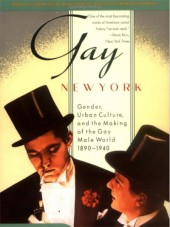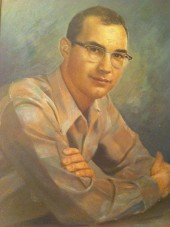
Gay New York: Gender, Urban Culture, and the Making of the Gay Male World, 1890–1940
by George Chauncey
Published by Basic Books
Published May 19, 1995
Nonfiction: LGBT History
496 pages
Find on Amazon: Hardback • Paperback
Reviewed by Billy Glover
Submitted December 25, 2008

In a sense I am asking what others thought about the book Chauncey did on Gay New York, with only a small thought on Faderman and Timmons’ Gay L.A. and anticipating criticism of C. Todd White’s coming book, Pre-Gay L.A.
It seems strange to be reading it and thinking about it in this season, but I came across it and glanced at it and wanted to share my thoughts and wonder what others thought.
In the first place, like too many critics, I am upset that he didn’t write the book I expected. After re-reading the phrase on the cover, saying that it is in part about urban culture I guess that excuses him for writing a book on historical New York and using gay men as a catalyst, rather than vice versa.
So what I got is a history of New York mainly on prohibition, black culture and Harlem, and how drag queens were mixed in all of this, such as at gay balls, but also in straight nigh clubs, etc.
And it sure seems to me that what he says in the intro is the opposite of what we get in the text. Which is good since I disagree with his assertion that says we were out in those days. His text proves otherwise, except for drag queens of course.
It is a good guide to the businesses of New York, the cafes, cafeterias, night clubs, housing, and drag queens hung around these places, with and without acceptance.
What he says and shows is what we have said all of our existence as a resource on homosexual issues at ONE/HIC. It was nonsense for some closet types to come into our offices and say, “Oh life was (usually only on a holiday or living unlike the locals) wonderful in Mexico, Holland, or some other place.” What we got from visitors who lived in those places was, of course: “Oh, life is so good here in America.”
And as to the terms, such as closet, he is not very accurate. The list of who he talked to includes Dorr Legg and Harry Hay — I always question the “professionalism” of a researcher who comes to the main source of early gay history — Southern California, and only talks to a few people who made that history and ignores what might have been a different view from others, such as obviously Don Slater. But we sure did use the term “closet” in the early ’60s.
And it is strange that he uses up the first 25 or so pages talking about the terms gay, etc, and yet ignores the history from the founders of early Mattachine and ONE, Inc. Of course these were not in New York. And what he has to say about drag queens in New York is probably exactly the same “history” as in Los Angeles.
And after reading all these pages about bar raids, organizations urging the law to attack places homosexuals — meaning drag queens hang out at — how can he say that there was a gay world in New York in these years?
Why are we then, or now, to accept drag queens as the gay world? What per cent of homosexuals in New York, or L.A., were “out” in those years? Where are their institutions? Drag Balls, which seem to have been well known and attended by non-gays?
It is interesting that he does in a sense point out that the reason why it was the lower-class whites who “accepted” queers — which term was first used, then opposed and today is back in use — was because they were not worried about their “standing” or masculinity when the ones they were dealing with were pseudo women.
What is more troubling, then and now, is what I see as the Black community not liking homosexuals, who were the only whites who would interact with blacks. Blacks wanted “normal” whites to interact, that would have made them feel equal. They had no need to feel equal to drag queens who were certainly not liked by “average” white.
It confirms what a Jew said in the civil rights era. I think it was in a small publication called a Minority of One (Mississippi) when the editor said Jews did not feel very helped by having having such minorities as Unitarians come to a meeting. They would have actual progress only when good ol’ Southern Baptists showed up; that would indicate that real society was accepting them and wanted to work with them. Drag queens were not an are not “real” society, even real gay society.
The book I wanted could have been done well in about a third the length of this book. There are too many “examples” given to make a point, over and over. How many names of bars do I need to get the point? I do find speculation that prohibition caused gay bars to come interesting — but I had that from many books talking about how prohibition was a total failure and caused more harm than good — again, unintended consequences of the rightwing religious people, no matter how good their intentions. But that is not a gay world.
And I don’t accept the “research” on how different ethnic groups(?) — how many Italians or Irish dealt with drag queens — accepted or didn’t accept drag queens — again they did not deal with the normal homosexuals then.
I have no dog in this fight. I just have been in an office (and publication) open daily for anyone seeking information on homosexuality, from the ’60s to the ’90s, and find any book or claim that goes against our 30 or 40 years of experience must meet a high standard to be believed. This book does not come close.
Did he have an agenda to start with?

